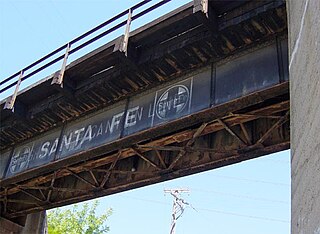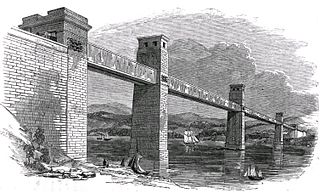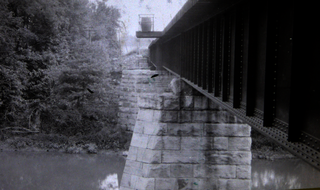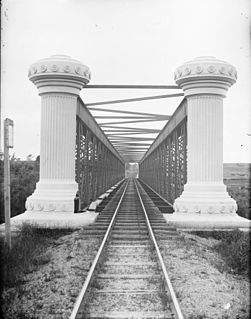This article needs additional citations for verification .(April 2020) |


A lattice girder is a truss girder where the load is carried by a web of latticed metal. [1]
This article needs additional citations for verification .(April 2020) |


A lattice girder is a truss girder where the load is carried by a web of latticed metal. [1]
The lattice girder was used prior to the development of larger rolled steel plates. It has been supplanted in modern construction with welded or bolted plate girders, which use more material but have lower fabrication and maintenance costs.
The term is also sometimes used to refer to a laced strut [2] or laced tie, structural members commonly made using a combination of structural sections connected with diagonal lacing. This form allows a strut to resist axial compression and a (tie) to resist axial tension. A lattice girder, like any girder, primarily resists bending.
The component sections may typically include metal beams, channel and angle sections, with the lacing elements either metal plate strips, or angle sections. The lacing elements are typically attached using either hot rivets or threaded locator bolts. As with lattice girders, laced struts and ties have generally been supplanted by hollow box sections, which are more economic to produce with modern technology. In some case seismic retrofit modifications replace riveted lacing with plates bolted in place.

The Tay Bridge carries the railway across the Firth of Tay in Scotland between Dundee and the suburb of Wormit in Fife. Its span is 2.75 miles. It is the second bridge to occupy the site.

A truss is an assembly of members such as beams, connected by nodes, that creates a rigid structure.

Seismic retrofitting is the modification of existing structures to make them more resistant to seismic activity, ground motion, or soil failure due to earthquakes. With better understanding of seismic demand on structures and with our recent experiences with large earthquakes near urban centers, the need of seismic retrofitting is well acknowledged. Prior to the introduction of modern seismic codes in the late 1960s for developed countries and late 1970s for many other parts of the world, many structures were designed without adequate detailing and reinforcement for seismic protection. In view of the imminent problem, various research work has been carried out. State-of-the-art technical guidelines for seismic assessment, retrofit and rehabilitation have been published around the world – such as the ASCE-SEI 41 and the New Zealand Society for Earthquake Engineering (NZSEE)'s guidelines. These codes must be regularly updated; the 1994 Northridge earthquake brought to light the brittleness of welded steel frames, for example.

A plate girder bridge is a bridge supported by two or more plate girders.

A lattice bridge is a form of truss bridge that uses many small, closely spaced diagonal elements forming a lattice. The lattice Truss Bridge was patented in 1820 by architect Ithiel Town.

A girder is a support beam used in construction. It is the main horizontal support of a structure which supports smaller beams. Girders often have an I-beam cross section composed of two load-bearing flanges separated by a stabilizing web, but may also have a box shape, Z shape, or other forms. A girder is commonly used to build bridges.

The Runcorn Railway Bridge, Ethelfleda Bridge or Britannia Bridge crosses the River Mersey at Runcorn Gap between Runcorn and Widnes in Cheshire, England. It is alongside the Silver Jubilee Bridge. The bridge is recorded in the National Heritage List for England as a Grade II* Listed building.

A box or tubular girder is a girder that forms an enclosed tube with multiple walls, as opposed to an I- or H-beam. Originally constructed of riveted wrought iron, they are now made of rolled or welded steel, aluminium extrusions or prestressed concrete.

The Usk Railway Bridge is a railway viaduct in Newport city centre, Wales. It crosses the River Usk in an east—west direction, carrying the Great Western Main Line.

A Howe truss is a truss bridge consisting of chords, verticals, and diagonals whose vertical members are in tension and whose diagonal members are in compression. The Howe truss was invented by William Howe in 1840, and was widely used as a bridge in the mid to late 1800s.

The Hadley Parabolic Bridge, often referred to locally as the Hadley Bow Bridge, carries Corinth Road across the Sacandaga River in Hadley, New York, United States. It is an iron bridge dating from the late 19th century.

The Clinton Falls Bridge, also known as the Old Mill Bridge and formally as Bridge L-5573, is a historic steel Pratt through truss bridge that spans the Straight River in Clinton Falls Township, Minnesota. It was listed on the National Register of Historic Places in 1997 as Bridge No. L-5573 for having local significance in the theme of engineering. It was nominated for being an example of early steel truss bridge design in Minnesota.

A balloon flange girder or (colloquially) balloon topper is a form of vertical I-beam wrought iron plate girder, where the top flange, instead of being a simple flat plate, is extended into a hollow tube. When a girder is subjected to a positive bending moment the top flange acts in compression making a flat plate flange more susceptible to local buckling than the balloon flange is.

The Monocacy River Railroad Bridge and Viaduct is a 326-foot (99 m) open deck steel girder bridge with two main spans crossing the river and two viaduct sections crossing the floodplain, south of Walkersville, Maryland. Originally constructed by the Frederick and Pennsylvania Line Railroad Company (F&PL). Construction began in late 1871, and continued until July 1872 when the railroad opened that year. It was rebuilt by the Pennsylvania Railroad prior first in 1900-1905 as an open deck riveted iron plate under girder bridge. In 1915, the bridge was surveyed as part of the Interstate Commerce Commission's ("ICC") effort to establish freight rates for the Parent railroad. In 1927, the Pennsylvania Railroad rebuilt the bridge again using deeper and thicker steel girders, but leaving the masonry piers intact. In 1972, the two 85 foot river spans were washed out by Hurricane Agnes. In 1982, the State of Maryland purchased the bridge as part of the railroad line. In 1995, the State rebuilt the river spans and Pier 3 which is located in the middle of the river crossing was completely reconstructed using concrete to replace the original masonry foundations. In 2015, the State performed minor maintenance on the structure and painted some spans.
As of 2016, the bridge is in active rail service, operated by the Walkersville Southern RR.

The Longford Railway Bridge is a railway bridge spanning the South Esk River, in Longford, Tasmania. The Western Railway Line travels over the bridge, enabling freight movement to/from the major Container ports of Burnie and Devonport and the rest of the state. In 1978, it was listed in the now-defunct Register of the National Estate.

Splitters Creek Railway Bridge is a heritage-listed railway bridge across Splitters Creek on the Bundaberg - Mount Perry Line, between Oakwood and Sharon in the Bundaberg Region, Queensland, Australia. It was built from 1879 to 1880 by J & A Overend. It was added to the Queensland Heritage Register on 21 October 1992.

The Straight Street Bridge is a vehicular bridge over the Passaic River in Paterson, New Jersey, that is listed on the National Register of Historic Places.

The Dubbo rail bridge over Macquarie River - Wambuul is a heritage-listed railway bridge on the Main Western line across the Macquarie River, located west of the Dubbo central business district in New South Wales, Australia. It was designed by John Whitton as the Engineer-in-Chief for the New South Wales Government Railways. The bridge was built during 1884 by Benjamin Barnes, with ironwork by Cochrane & Co, Middlesborough, England. The railway bridge is also known as the Dubbo Lattice Railway Bridge. The property is owned by RailCorp, an agency of the Government of New South Wales. The bridge was added to the New South Wales State Heritage Register on 2 April 1999 and was listed on the Register of the National Estate on 18 April 1989.

The Long Cove Creek railway viaducts are heritage-listed railway viaducts which carry the Main Suburban railway line over Long Cove Creek between the suburbs of Lewisham and Summer Hill in Sydney, New South Wales, Australia. The viaducts were designed and built by the New South Wales Government Railways. The property is owned by RailCorp, an agency of the Government of New South Wales. It was added to the New South Wales State Heritage Register on 2 April 1999.